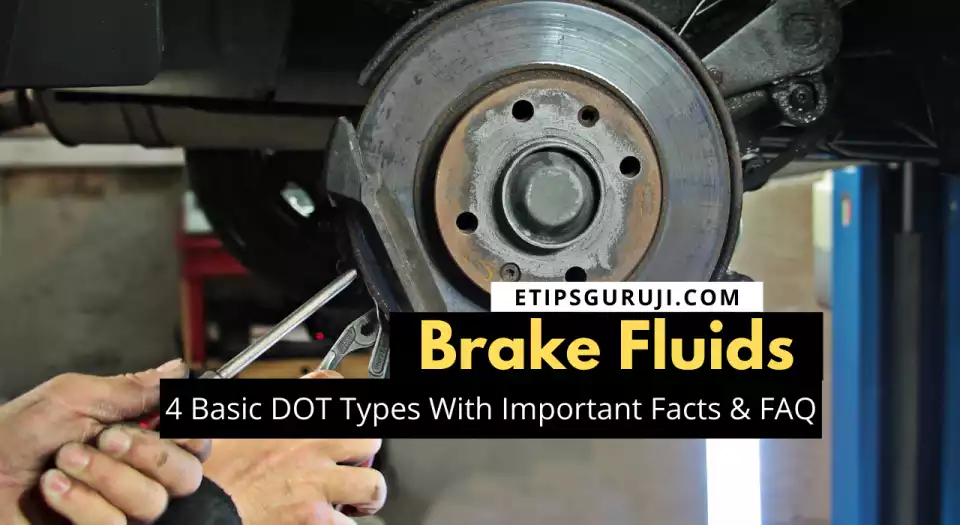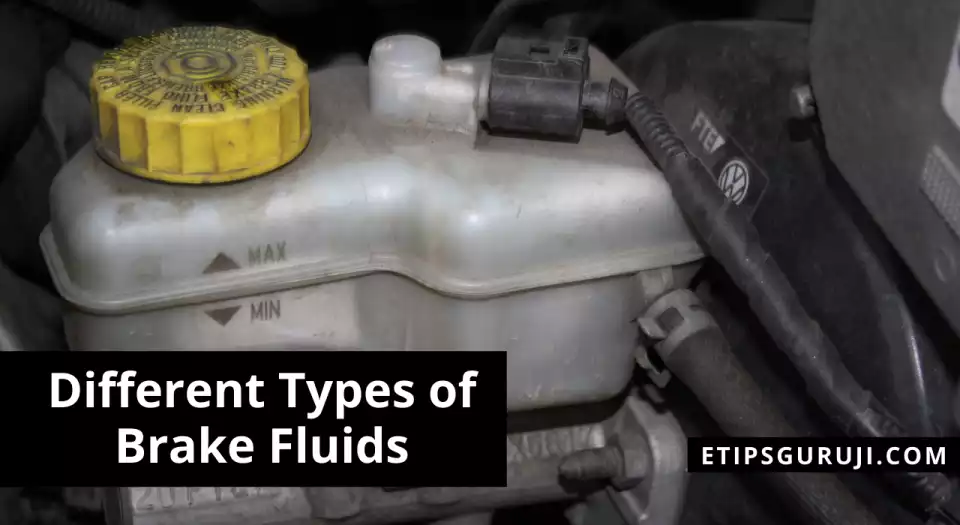Brake Fluids: 4 Basic DOT Types With Important Facts & FAQ

Brakes play a vital role in preventing car accidents. But many times brakes failure can cause car crashes. And one of the most causes of brake failure is the leakage of brake fluids.
Brake fluids are a type of hydraulic fluids that are used for hydraulic systems such as hydraulic brake and hydraulic clutch to perform certain sets of tasks like braking systems in cars.
Through this post, we give detailed information on brake fluids with its facts and types.
What are Brake fluids?

We already define the term brake fluid— But in short, brake fluids are certain types of fluids that have a compression value which makes them a perfect choice for hydraulics. Moreover, they are used in braking systems of various vehicles such as automobiles, motorcycles, light trucks, and some bicycles.
Brake fluid generally operated when there is a high pressure and high temperatures are required. And without using the fluid, your car can’t stop even when you press the brake pedal.
Brake fluid is a non-compressed material that is found inside the brake lines. It transmits the fluid into motion when the car driver presses the brake pedal.
The pressure created by pressing the brake pedal causes the brake rotors to squeeze, which then comes in contact with the wheels, and it will slow down or stops the wheel and freezes the vehicle motion.
Some Common Facts About Brake Fluids
- Use prescribed brake fluids. So, never use DOT 5 brake fluid in that type of vehicle that uses DOT 3 or DOT 4. Moreover, you can use DOT 4 instead of DOT 3, but not vice versa.
- Do not scatter the fluids over the car parts because it can damage paint surfaces and finishes.
- Wash your hands when you come in contact with brake fluid.
- Never mix DOT 5 with glycol fluids in cars with Anti locking braking system.
In India, about 22 percent of all car crashes can be directly connected to brake failure, and daily almost 3,700 people are killed globally in road traffic crashes. But most of the accidents can be prevented if they take proper care of the vehicles. To avoid this situation use better brakes fluid for your vehicles.
People Also Read:
- Why Won’t My Car Start- 11 Basic Reason Along With Solutions
- How to Hotwire a Car? | 3 Best-Known Cheat to Hotwire a Car
DOT and Brake Fluids
DOT stands for the Department of Transportation which set safety regulation to classifies brake fluids. For the acceptable performance of different brake fluids, that is related to the boiling point and chemical composition. The DOT specifies two reference tests these are:
- Dry boiling point — the boiling point of fresh fluid.
- Wet boiling point — the boiling point once the moisture is absorbed by the fluid.
Different Types of Brake Fluids

There are four different types of brake fluids that are available now. Let us consider them one by one.
Type 1: DOT 3
It is a common type of brake fluid which is quite popular and is being used for a long time in the braking system of domestic vehicles. DOT 3 is glycol-ether based brake fluids which contain a mixture of poly-alkylene glycol and ether. In general cases, DOT 3 absorbs moisture from the atmosphere.
Important Facts and Properties:
- DOT 3 has a lower boiling point with the tendency to absorb water more easily
- Fresh DOT 3 has a boiling point
- Dry boiling point- 401 degrees Fahrenheit (205°C)
- Wet boiling point- 284 degrees Fahrenheit (140°C)
- DOT 3 Viscosity
- Viscosity at -40 °C°F: ≤ 1500 mm2/s
- Viscosity at 100 °C (212 °F): ≥ 1.5 mm2/s
- According to SAE, DOT 3 can absorb 2% of its volume in water in a year. Excessive moisture for a long time will cause corrosion in the brake system, causing issues such as vapor-lock or spongy paddles.
Note: It can easily absorb water from the air, so containers of brake fluids are always tightly sealed. DOT3 is highly corrosive, therefore great care must be taken.
Type 2: DOT 4
DOT 4 is widely used as interchangeable braking fluids in many vehicles in place of DOT 3. However, DOT 4 is also a glycol-ether based brake fluids but additionally, it contains borate ester (boron-containing oxyanions) which significantly improves the DOT 4 boiling point.
This all together makes DOT 4 brake fluids to be a good performer brake fluids which also assures higher reliability.
Important Facts:
- DOT4 has a higher boiling point. Therefore, it does not absorb moisture rapidly.
- It is 2 times more expensive than the DOT 3 brakes fluid.
- DOT 4 boiling point
- Dry boiling point- 446 degrees Fahrenheit (230°C)
- Wet boiling point- 311 degrees Fahrenheit (155°C)
- DOT 4 Viscosity
- Viscosity at -40 °C°F: ≤ 1800 mm2/s
- Viscosity at 100 °C (212 °F): ≥ 1.5 mm2/s
Type 3: DOT 5
DOT 5 is silicone-based brake fluid, which means it does not absorb water easily from the surrounding atmosphere. It usually has a violet color to distinguish it from the DOT 3, 4, and 5.1 amber colors.
However, air bubbles do not bleed out, so it is not used with anti-lock braking systems (ABS) as well as glycol-based fluids.
Important Facts:
- DOT 5 has a very high boiling point. Therefore, it absorbs a very small amount of water while in service.
- DOT 5 boiling point
- Dry boiling point- 500 degrees Fahrenheit (260°C)
- Wet boiling point- 356 degrees Fahrenheit (180°C)
- DOT 5 has stable Viscosity
- Viscosity at -40 °C°F: ≤ 900 mm2/s
- Viscosity at 100 °C (212 °F): ≥ 1.5 mm2/s
- It is 4 times more expensive than DOT 3
Note: DOT 5 should not be mixed with any other fluid otherwise react badly with each other and corrode the vehicle’s braking system.
Type 4: DOT 5.1
DOT 5.1 is the non-silicon version of DOT 5 which are also glycol-based brake fluids that have amber color. These types of hydraulic fluids provide the highest-graded boiling point. Therefore, they are the best performer in all of the above-mentioned types.
Important Facts:
- DOT 5.1 has a dry boiling point of 270°C and a wet boiling point of 180°C
- DOT 5.1 is around 14 times more expensive than DOT 3.
Here our topic on “Brake Fluid” ends. So, let’s review some common questions on brake fluids that people usually search on Google.
General FAQ
What kind of brake fluids do I need?
Ans. By checking the owner’s manual you can easily help determine what type of brake fluid your car needs. However, you can also determine this by checking the master cylinder reservoir cap.
What happens if the brake fluid is low?
Ans. A low brake fluid facilitates the low breaking system potential which completely decreases the efficiency of braking. This leads to an accidental situation where the vehicle is difficult to stop.
Is brake fluid all the same?
Ans. No, all brakes fluids are different and that’s why they are categorized on DOT types. For instance, DOT3, and DOT4 are glycol-based liquids while DOT5 is silicon-based. Both DOT3 and DOT4 can absorb water but DOT5 cannot absorb water.
What vehicles use DOT 4 brake fluids?
Ans. The DOT 4 brake fluid is suitable for vehicles that do not use their braking systems aggressively and are typically found in police cars and racing vehicles.
